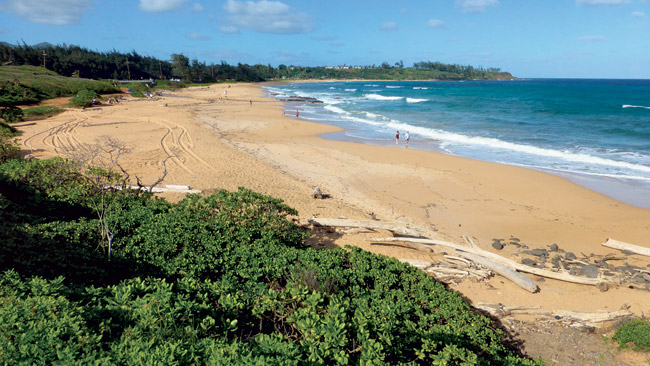Working Together To Save Lives

Beautiful Kealia Beach on Kauai’s eastern shoreline. Kealia is one of 10 lifeguarded beaches on Kauai | Ezekiel Ramirez photo
Through tragedy comes change, and in this case, change may ultimately save lives.
Beautiful Kauai is reeling after the 10th reported drowning on the Garden Isle this year. Seven of the victims were visitors and three were island residents, including 35-year-old Eleele resident John-Eric Parinas, who drowned while spearfishing with friends in waters off Glass Beach. Parinas is the eighth ocean drowning victim. The other two incidents happened in fresh water at Hanakapiai Stream and Wainiha River.
Hawaii’s first responders are well-trained professionals who risk their lives in order to save others. Several of my closest friends are on the front line, and I often wonder how they cope with the stresses of their job, especially when there are fatalities.
Some will tell you they try not to get “emotionally involved” during a search-and-rescue effort, but make no mistake about it, they too feel the pain when someone dies. And having grown up on Kauai, I can assure you the entire island community is mourning with the families who suffered tragedy in our waters.
“The people on Kauai are definitely feeling it,” says former Kauai County Councilman Dickie Chang, host, producer and director of the popular Wala’au
community program. “These victims have their own careers, families and lives, and all of that has been tragically cut short. I’ve been at several command posts, and our emergency personnel are right there grieving with the families.”
Kauai county officials and representatives from Kauai Visitors Bureau, Kauai Lifeguard Association and Water Awareness Visitor Education Program are extremely concerned about the recent drownings on the Garden Isle, and they’re taking action to help prevent more tragedies.
Chang has teamed with Kalani Vierra, Kauai Fire Department Ocean Safety Bureau Operations supervisor, and Dr. Monty Downs, Kauai Lifeguard Association president, and produced a water-safety education video.
“We’re going to launch the video in mid-April at baggage claim areas at Lihue Airport so visitors and residents can receive the safety messages and information the moment they get off their flights,” says Chang of the video, which was funded by the Rotary Club of Kapaa. “We’re also in the process of having it aired in hotels, condominiums and timeshares that will have us. We also are trying to find ways to educate vacation rental companies.”
Chang says starting this week, Patrick Durkin of the Water Awareness Visitor Education program will begin training sessions at several hotels to educate employees on how to best inform guests about the dangers the ocean can present.
“The whole community is getting involved, and we’re going all out with our safety messages and measures,” says Chang. “Last year, we lost two people to drownings. This year, in nine weeks we’ve lost 10 people.”
There are 10 “lifeguarded” beaches on Kauai.
“Since 1990, more than 200 people have drowned in our ocean. More than 150 of these are visitors and virtually all of these drownings take place at unguarded beaches,” says Downs, who in the video urges visitors and residents to visit beaches that are staffed by lifeguards. “I’m also a realist, and I know some of you will venture out to unguarded beaches. That is why we’ve put up rescue tube stations at more than 200 places on Kauai.”
Vierra says it’s important to take 20 minutes to observe conditions, obey all warning signs and to have an emergency plan before entering the ocean.
“You want to educate yourself about the year-round conditions on our island,” says Vierra. “We have sand bottoms, we have sandbars, we have reefs, we have jetties, we have harbors and we have river mouths – that’s all the areas you can find rip currents. When in doubt, don’t go out!”
Besides the video, beach-safety guides are being made available at baggage claim areas and hotels, and beach-safety kiosk displays by Kauai Lifeguard Association also are planned.
“We need to continue to create and raise awareness,” says Chang. “Our efforts can and will save lives.”





